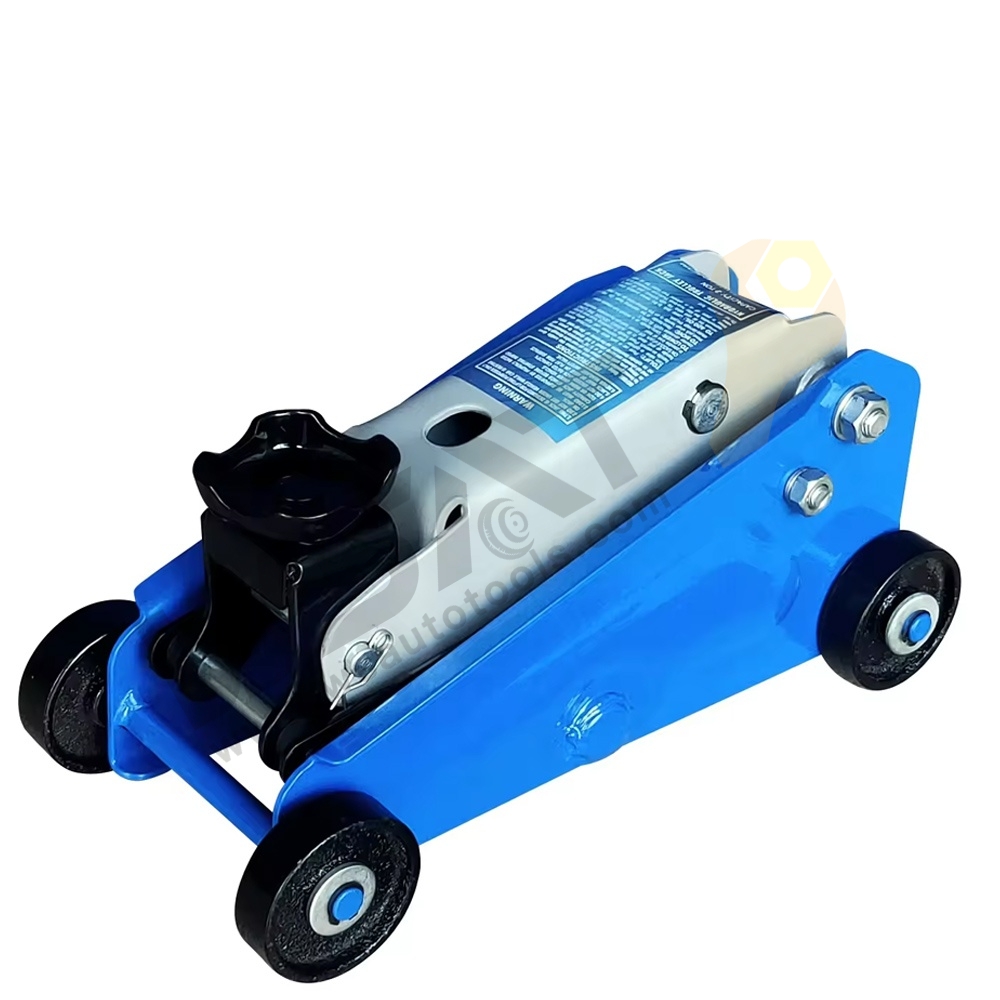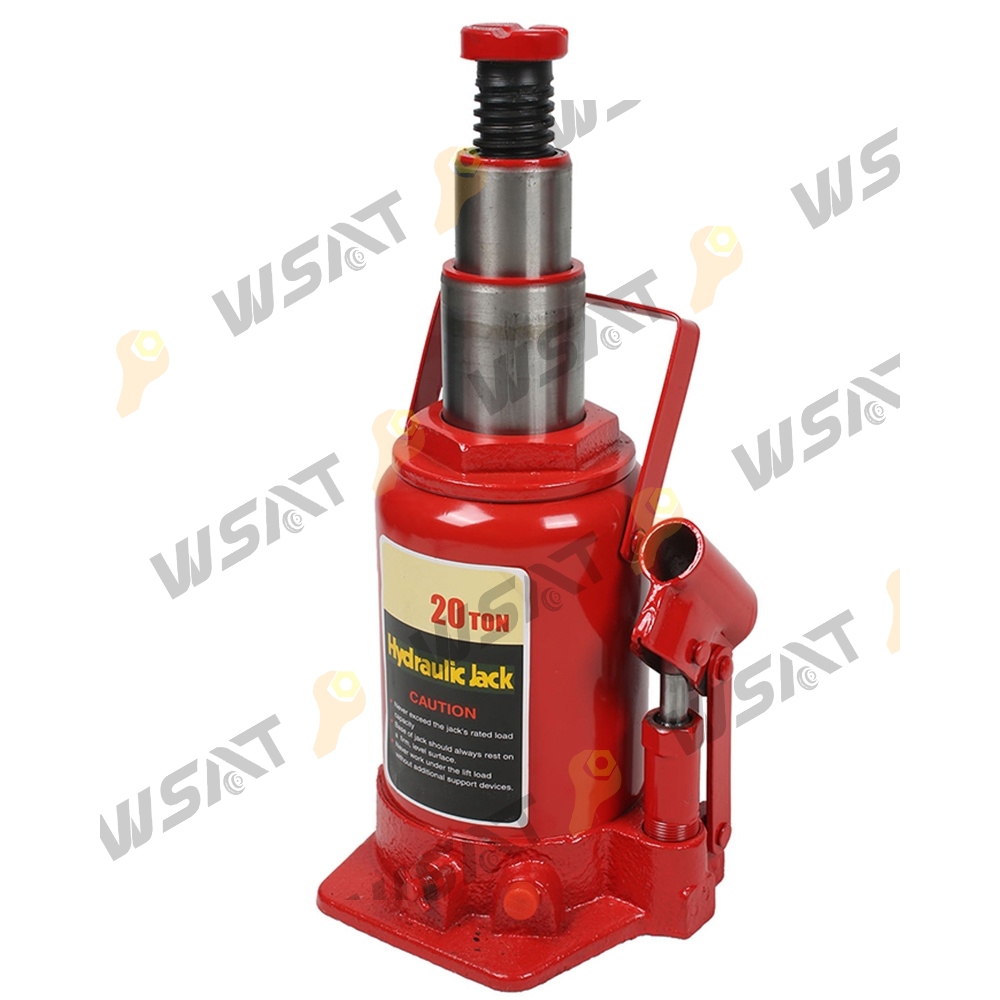1. What Is a Floor Jack?
Floor jacks are also known as trolley jacks. They have a flat wheeled body which mounts a hydraulic jack and possesses a lengthy handle. It rolls below the car and hydraulically elevates the lifting arm of the jack. You commonly pump the long handle to raise the saddle and lift the vehicle.
Because of their efficiency, speed and sturdiness, Floor jacks have become popular in automative workshops and garages.
Pros and Cons of Floor Jacks
Pros
Perfect for low-clearance vehicles: Because of their flat and wide design, floor jacks can slide under vehicles with just a few inches of ground clearance.
Stable and safe: The broad base and four-wheel design offer excellent stability during lifting.
Fast operation: With dual-piston pumps in many modern models, floor jacks can lift vehicles quickly and smoothly.
Easier positioning: You can easily roll the jack into the exact spot under the lifting point.
Cons
Heavy and bulky: Most floor jacks weigh between 30–100 pounds, making them hard to carry or use outside the garage.
Takes up storage space: Due to their length and size, they need a dedicated spot in your workshop or garage.
Higher cost: They are typically more expensive, especially if you go for high-end or low-profile models.
2. What Is a Bottle Jack?
A bottle jack is a compact, upright hydraulic jack that resembles a bottle. It has a narrow base and a vertical lifting piston. You operate it by pumping a small handle, causing the piston to rise and lift the load.
These jacks are popular among off-roaders, truck owners, and mechanics who need a strong, portable lifting tool.
Pros and Cons of Bottle Jacks
Pros
High lifting power: Bottle jacks can lift heavy vehicles, with common models offering 4 to 20 tons of capacity—ideal for trucks, RVs, and SUVs.
Compact and portable: They are easy to carry, store, or toss in your trunk for emergency use.
Simple construction: Fewer moving parts mean less chance of mechanical failure and easier maintenance.
Budget-friendly: You can often find a reliable bottle jack for a fraction of the price of a floor jack.
Cons
Limited ground clearance: Their vertical design requires more space under the vehicle, making them unsuitable for most sedans or sports cars.
Narrow base: On uneven surfaces, stability can be an issue, especially if the jack isn’t placed perfectly.
Manual effort required: Lifting can take more time and energy, especially if the jack doesn’t have dual pistons.
3. Which Jack Is Stronger?
Both floor jacks and bottle jacks come in a variety of lifting capacities, but bottle jacks generally offer greater lifting power in a smaller footprint. While a standard floor jack may have a 2- or 3-ton rating, bottle jacks commonly range from 4 to 20 tons.
This makes bottle jacks the better choice for lifting:
Heavy-duty vehicles
Commercial trucks
Farm tractors
Off-road rigs
Floor jacks, although often limited to 2–3 tons, are still sufficient for:
Compact cars
Sedans
Light SUVs
Important tip: Always choose a jack rated for at least 25% more than your vehicle's curb weight for added safety.
4. Which Jack Works for Low Cars?
If you own a car with low ground clearance, such as a sports car, coupe, or lowered sedan, a floor jack is almost always the better option.
Many low-profile floor jacks can fit under cars with just 3 inches of clearance. This makes them ideal for:
Tire changes on low vehicles
Oil changes without ramps
Suspension work
In contrast, most bottle jacks require 6 to 9 inches of clearance just to fit under the vehicle before lifting. They're poorly suited for anything with a low stance. Some specialty bottle jacks do have a shorter starting height, but they often sacrifice lifting range.
5. Which One Is Easier to Carry?
Bottle jacks are significantly more portable than floor jacks. Their small, upright form factor makes them easy to carry with one hand and store in tight spaces, like your vehicle's trunk or under the back seat.
This makes bottle jacks ideal for:
Roadside emergencies
Keeping in your car's emergency kit
Portable toolboxes
Floor jacks, on the other hand, are built for shop or garage use. They can be heavy (some over 70 lbs) and awkward to load into a car. Even compact models still require a fair amount of storage space. If portability is your top priority, a bottle jack is the obvious winner.
6. Which Jack Should You Buy?
Ultimately, the right jack depends on your situation:
Choose a Floor Jack if you:
Own a low-clearance car.
Perform frequent maintenance or repairs.
Value speed, stability, and ease of use.
Have space in your garage.
Choose a Bottle Jack if you:
Drive a high-clearance vehicle like an SUV or truck.
Need a portable jack for roadside emergencies.
Are on a tight budget.
Don't need to lift your car often.
Floor jacks and bottle jacks both have their strengths. The key is to match the tool to your vehicle type, usage habits, and storage situation. A well-chosen jack can save time, reduce effort, and most importantly—keep you safe during car maintenance. Feel free to contact us!







